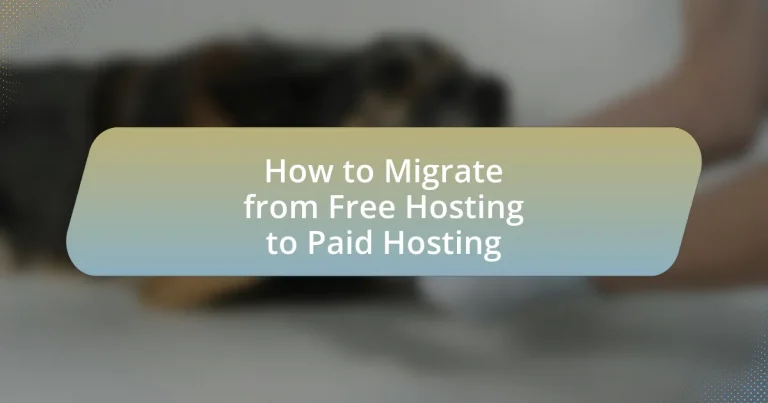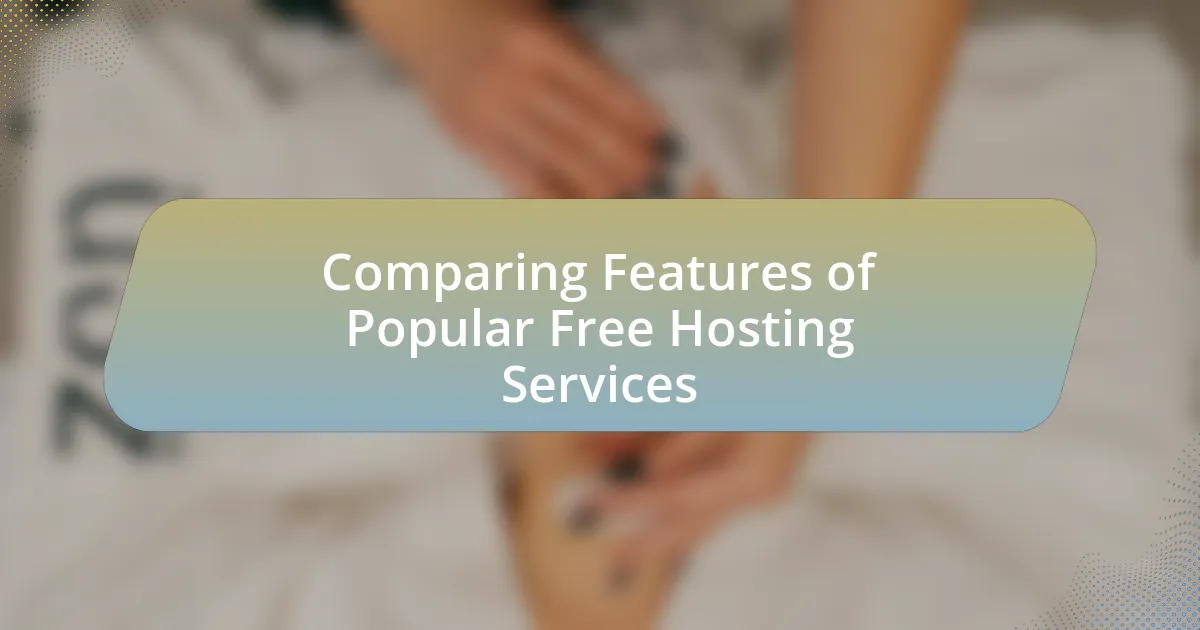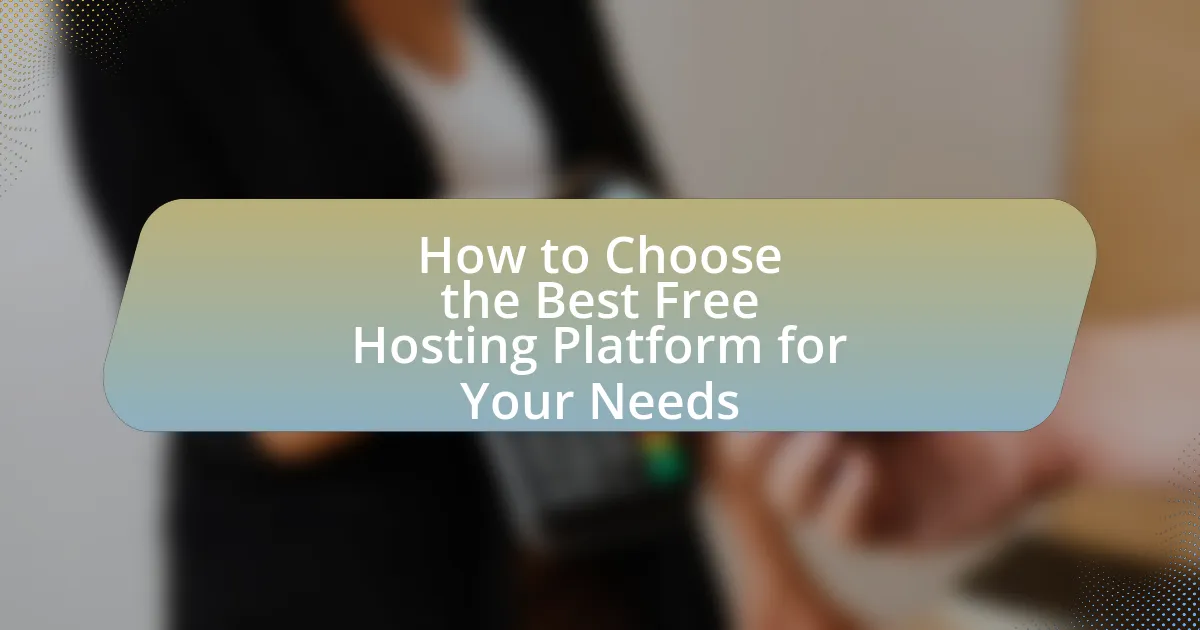Migrating from free hosting to paid hosting is a crucial step for website owners seeking improved performance, reliability, and security. The article outlines the essential process of migration, including selecting a suitable paid hosting provider, backing up website data, transferring files, and updating DNS settings. It highlights the limitations of free hosting services, such as restricted bandwidth and lack of support, while emphasizing the benefits of paid hosting, including dedicated resources and enhanced security features. Additionally, the article provides best practices for managing a new hosting account, optimizing website performance, and leveraging customer support effectively.
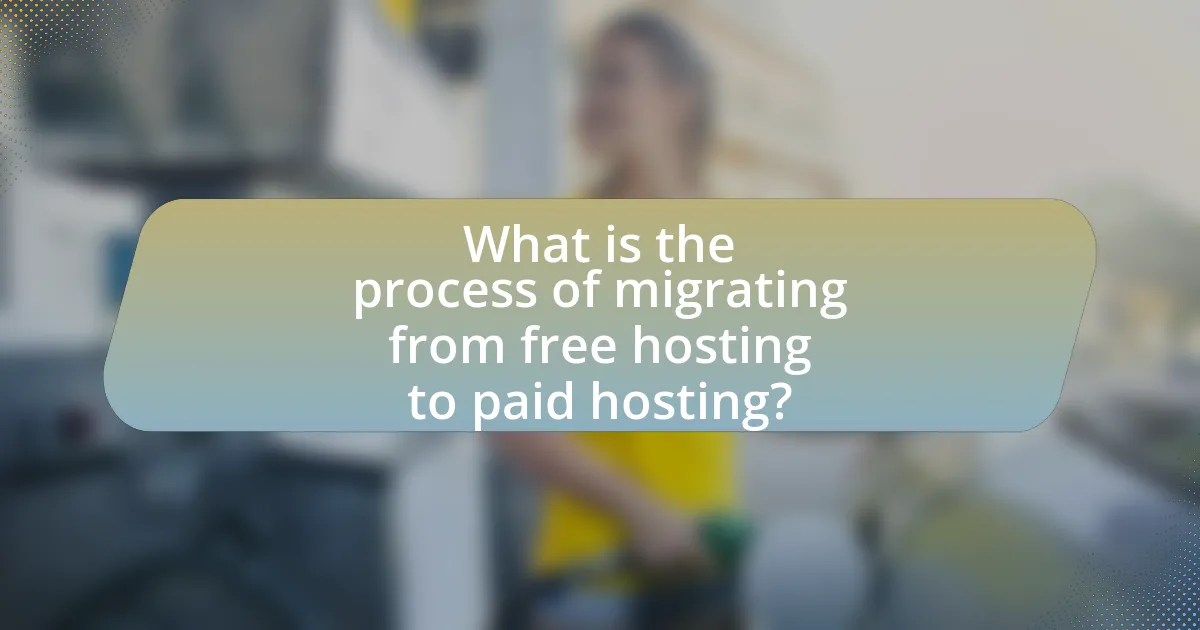
What is the process of migrating from free hosting to paid hosting?
The process of migrating from free hosting to paid hosting involves several key steps. First, select a paid hosting provider that meets your needs, considering factors such as storage, bandwidth, and customer support. Next, sign up for the chosen hosting plan and obtain your new hosting account details, including FTP credentials and control panel access.
After securing the new hosting account, back up your website files and databases from the free hosting service. This can typically be done through the control panel or an FTP client. Once the backup is complete, upload the files and databases to the new paid hosting account using the provided FTP credentials or control panel tools.
Finally, update your domain’s DNS settings to point to the new hosting provider’s servers, which may take up to 48 hours to propagate. This process ensures that visitors are directed to your website on the new paid hosting service.
Why should you consider migrating from free hosting to paid hosting?
Migrating from free hosting to paid hosting is essential for improved performance, reliability, and security. Free hosting often comes with limitations such as slower loading speeds, frequent downtime, and lack of customer support, which can negatively impact user experience and website credibility. In contrast, paid hosting services typically offer dedicated resources, enhanced security features, and 24/7 technical support, ensuring that websites run smoothly and securely. According to a study by HostingAdvice, 70% of users reported that website speed directly affects their purchasing decisions, highlighting the importance of reliable hosting for business success.
What limitations do free hosting services impose?
Free hosting services impose several limitations, including restricted bandwidth, limited storage space, and lack of customer support. These constraints often result in slow website performance and potential downtime due to traffic overload. Additionally, free hosting typically includes mandatory advertisements, which can detract from the user experience and brand image. Security features are often minimal or nonexistent, leaving websites vulnerable to attacks. Furthermore, users may face restrictions on domain names, often being required to use subdomains instead of custom domains, which can hinder professional branding.
How can paid hosting enhance your website’s performance?
Paid hosting enhances your website’s performance by providing dedicated resources, faster loading times, and improved reliability. Unlike free hosting, which often shares server resources among multiple users, paid hosting allocates specific bandwidth and storage to each website, reducing latency and increasing speed. For instance, a study by Google found that a one-second delay in loading time can lead to a 20% decrease in conversions, highlighting the importance of speed for user engagement. Additionally, paid hosting typically includes better security features and customer support, which contribute to overall site stability and performance.
What are the key steps involved in the migration process?
The key steps involved in the migration process from free hosting to paid hosting include planning, backing up data, selecting a paid hosting provider, transferring files, updating DNS settings, and testing the new setup.
Planning involves assessing the current website’s needs and determining the appropriate paid hosting plan. Backing up data ensures that all website files, databases, and configurations are securely saved before migration. Selecting a paid hosting provider requires evaluating options based on performance, support, and pricing. Transferring files entails moving website content to the new server, often using FTP or a migration tool. Updating DNS settings is necessary to point the domain to the new hosting provider, which may take some time to propagate. Finally, testing the new setup confirms that the website functions correctly on the paid hosting platform.
How do you assess your current hosting needs?
To assess your current hosting needs, evaluate your website’s traffic, resource requirements, and performance expectations. Analyzing metrics such as average monthly visitors, peak traffic times, and the types of content hosted (e.g., images, videos) helps determine the necessary bandwidth and storage. For instance, if your site experiences over 10,000 monthly visitors, a shared hosting plan may not suffice, and a VPS or dedicated server could be more appropriate. Additionally, consider the scalability options of your hosting provider to accommodate future growth, as 70% of businesses report needing to upgrade their hosting solutions within the first year due to increased traffic or resource demands.
What factors should you consider when choosing a paid hosting provider?
When choosing a paid hosting provider, consider factors such as reliability, performance, customer support, pricing, and scalability. Reliability is crucial; a provider with a 99.9% uptime guarantee ensures your website remains accessible. Performance, including server speed and load times, affects user experience and SEO rankings. Customer support should be available 24/7 through multiple channels, as timely assistance is vital for resolving issues. Pricing should align with your budget while offering value, including features like bandwidth and storage. Scalability is important for future growth; choose a provider that allows easy upgrades as your website expands.
What preparations are necessary before migration?
Before migration, it is essential to back up all website data, including files, databases, and configurations. This ensures that no information is lost during the transition. Additionally, users should choose a suitable paid hosting plan that meets their website’s requirements, such as storage, bandwidth, and support. It is also important to review and update domain settings to point to the new hosting provider. Finally, testing the website on the new host before fully switching over can help identify any issues that need to be resolved.
How do you back up your website data effectively?
To back up your website data effectively, utilize automated backup solutions that regularly save your files and databases. These solutions, such as plugins for content management systems like WordPress or services like CodeGuard, ensure that your website data is consistently backed up without manual intervention. According to a study by the Online Backup Market, 60% of businesses that experience data loss shut down within six months, highlighting the importance of regular backups. Additionally, storing backups in multiple locations, such as cloud storage and external hard drives, further protects against data loss due to hardware failure or cyberattacks.
What should you do to ensure a smooth transition of your domain?
To ensure a smooth transition of your domain, you should back up all website files and databases before initiating the migration. This step is crucial because it protects your data from loss during the transfer process. Additionally, you must update your domain’s DNS settings to point to the new hosting provider, which typically involves changing the nameservers to those provided by the paid hosting service. It is also important to verify that the new hosting environment is properly configured to support your website’s requirements, such as PHP version and database compatibility. Finally, testing the website on the new host before fully switching over can help identify any issues that need to be resolved, ensuring a seamless transition.

How do you execute the migration from free hosting to paid hosting?
To execute the migration from free hosting to paid hosting, first, select a suitable paid hosting provider that meets your website’s needs. After choosing the provider, back up all website files and databases from the free hosting service to ensure no data is lost during the transition. Next, upload the backed-up files and databases to the new paid hosting account using FTP or the hosting provider’s file manager. Update the domain’s DNS settings to point to the new hosting server, which may take up to 48 hours to propagate. Finally, test the website on the new hosting to confirm that everything functions correctly. This process is validated by the common practice of backing up data and updating DNS settings during hosting migrations, ensuring a smooth transition.
What are the technical steps to migrate your website?
To migrate your website from free hosting to paid hosting, follow these technical steps: First, choose a paid hosting provider that meets your needs. Next, back up your website files and database from the free hosting service. After that, upload the backed-up files to the new paid hosting server using FTP or a file manager. Then, import your database to the new hosting environment using a tool like phpMyAdmin. Update your website’s configuration files to reflect the new database credentials and server settings. Finally, change your domain’s DNS settings to point to the new hosting provider, ensuring that you allow time for DNS propagation. These steps are essential for a successful migration, as they ensure that all website data is transferred and configured correctly.
How do you transfer files from free hosting to paid hosting?
To transfer files from free hosting to paid hosting, use an FTP client to connect to both hosting accounts. First, download the files from the free hosting server to your local computer using the FTP client. Then, connect to the paid hosting server with the same FTP client and upload the files from your local computer to the new server. This method is effective because FTP clients facilitate the transfer of multiple files and directories efficiently, ensuring that all data is moved correctly.
What is the process for updating DNS settings after migration?
To update DNS settings after migration, first, access your domain registrar’s control panel. Then, locate the DNS management section where you can edit the DNS records. Update the A record to point to the new server’s IP address and modify any other relevant records, such as CNAME or MX records, to reflect the new hosting environment. Finally, save the changes and allow time for DNS propagation, which can take up to 48 hours. This process ensures that your domain directs traffic to the new hosting provider effectively.
How can you verify that the migration was successful?
To verify that the migration was successful, check the functionality of the website on the new paid hosting environment. This includes ensuring that all pages load correctly, links are functional, and databases are accessible. Additionally, compare the website’s performance metrics, such as loading speed and uptime, before and after the migration. Monitoring tools can provide insights into these metrics, confirming that the site operates as intended post-migration.
What checks should you perform to ensure your website is functioning properly?
To ensure your website is functioning properly, perform checks on website loading speed, broken links, mobile responsiveness, and server uptime. Website loading speed should be under three seconds, as studies show that 40% of users abandon a site that takes longer. Check for broken links using tools like Screaming Frog, as broken links can negatively impact user experience and SEO. Mobile responsiveness is crucial, with over 50% of web traffic coming from mobile devices; use Google’s Mobile-Friendly Test to verify this. Lastly, monitor server uptime, aiming for 99.9% availability, as downtime can lead to loss of traffic and revenue.
How do you troubleshoot common issues post-migration?
To troubleshoot common issues post-migration, first, verify that all files and databases have been transferred correctly. This can be done by comparing file sizes and checking database integrity through tools like phpMyAdmin. Next, check the website’s configuration settings, including the database connection strings and file permissions, as incorrect settings can lead to functionality issues. Additionally, monitor server logs for error messages that can provide insights into specific problems encountered after migration. For example, a 404 error may indicate missing files, while a 500 error could suggest server misconfigurations. Regularly testing website functionality, such as forms and links, ensures that everything operates as expected.
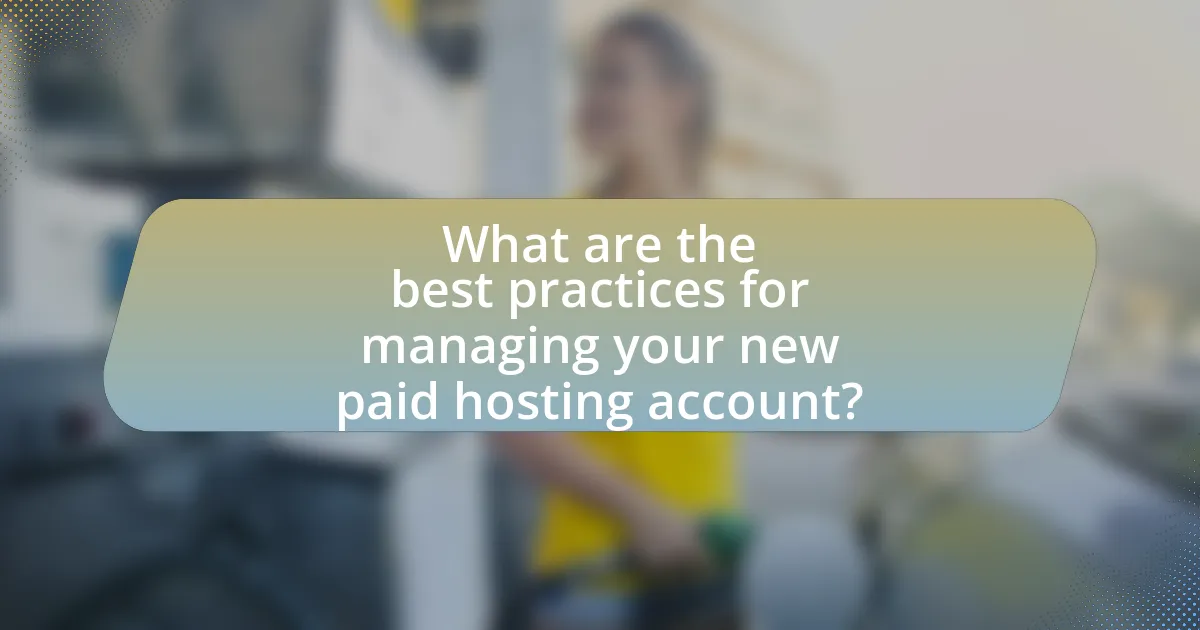
What are the best practices for managing your new paid hosting account?
The best practices for managing your new paid hosting account include regularly updating software, implementing strong security measures, and monitoring performance metrics. Regular software updates ensure that your website runs on the latest versions, reducing vulnerabilities; for instance, outdated plugins can lead to security breaches. Strong security measures, such as using SSL certificates and firewalls, protect your data and enhance user trust. Monitoring performance metrics, like uptime and load times, allows you to identify issues early and optimize user experience. According to a study by Google, a one-second delay in load time can lead to a 20% decrease in conversions, highlighting the importance of performance management.
How can you optimize your website on paid hosting?
To optimize your website on paid hosting, focus on enhancing performance, security, and user experience. Implementing a Content Delivery Network (CDN) can significantly reduce load times by distributing content across multiple servers globally. Additionally, utilizing caching mechanisms, such as server-side caching and browser caching, can improve site speed by storing frequently accessed data.
Regularly updating software, including the Content Management System (CMS) and plugins, ensures security and functionality, reducing vulnerabilities that could be exploited. Furthermore, optimizing images and other media files for web use decreases loading times, contributing to a better user experience.
Monitoring website performance through tools like Google PageSpeed Insights provides actionable insights for further optimization. According to a study by Akamai, a 100-millisecond delay in load time can decrease conversion rates by 7%, highlighting the importance of speed in user retention and engagement.
What tools can help you monitor your website’s performance?
Google Analytics is a powerful tool that helps monitor website performance by providing insights into traffic, user behavior, and conversion rates. It tracks metrics such as page views, bounce rates, and session duration, allowing website owners to analyze how visitors interact with their site. Additionally, tools like GTmetrix and Pingdom offer performance monitoring by assessing page load times and identifying bottlenecks, which can enhance user experience. These tools are widely used in the industry, with Google Analytics boasting over 29 million websites using its services, demonstrating its effectiveness in performance monitoring.
How do you ensure security and backups on your new hosting account?
To ensure security and backups on a new hosting account, implement strong password policies, enable two-factor authentication, and utilize SSL certificates for data encryption. Regularly scheduled automated backups should be configured to safeguard data, with options for both on-site and off-site storage to prevent data loss. According to a 2021 study by the Cybersecurity & Infrastructure Security Agency, organizations that implement multi-layered security measures reduce the risk of data breaches by up to 80%.
What tips can help you make the most of your paid hosting experience?
To make the most of your paid hosting experience, choose a hosting plan that aligns with your website’s needs, ensuring adequate resources for traffic and storage. Selecting a plan that matches your anticipated growth can prevent performance issues and downtime. Additionally, utilize the customer support services provided by your hosting provider, as they can assist with technical issues and optimize your setup. Research shows that 70% of users value responsive customer support, which can significantly enhance your hosting experience. Regularly back up your website data to avoid loss during unforeseen circumstances, as 30% of websites experience data loss at some point. Finally, take advantage of any included features, such as SSL certificates or content delivery networks, to improve security and performance.
How can you leverage customer support from your hosting provider?
You can leverage customer support from your hosting provider by utilizing their expertise to resolve technical issues, optimize your website performance, and ensure a smooth migration process. Hosting providers typically offer various support channels, such as live chat, email, and phone support, which can be accessed for immediate assistance. For instance, if you encounter difficulties during migration, their support team can guide you through the necessary steps, helping to minimize downtime and data loss. Additionally, many hosting providers have extensive knowledge bases and tutorials that can enhance your understanding of their services, further empowering you to make informed decisions during the migration from free to paid hosting.
What are the common pitfalls to avoid after migrating to paid hosting?
Common pitfalls to avoid after migrating to paid hosting include neglecting to update DNS settings, failing to back up data, and not optimizing website performance. Neglecting to update DNS settings can lead to downtime or accessibility issues, as the domain may still point to the old server. Failing to back up data can result in loss of important files during the transition, as unexpected issues may arise. Not optimizing website performance can lead to slower load times, which negatively impacts user experience and search engine rankings. According to a study by Google, a one-second delay in load time can lead to a 20% decrease in conversions, highlighting the importance of performance optimization post-migration.
